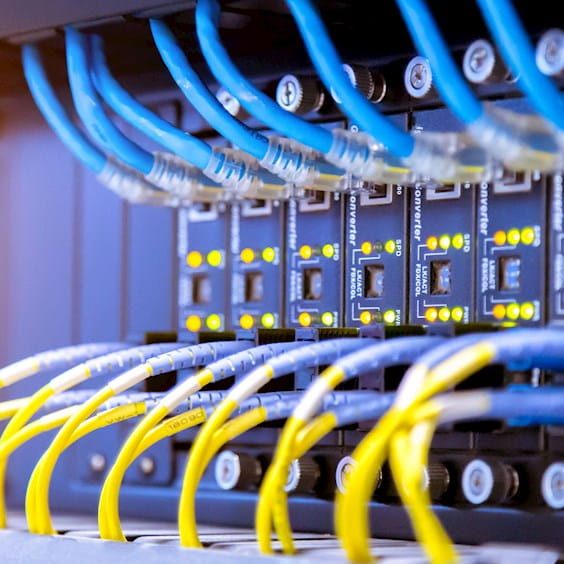The Infrastructure Investment & Jobs Act: What it means for utilities
Grant funding to expand fiber networks enables utilities to support connections through middle-mile and last-mile infrastructure
The Infrastructure Bill signed into law on Nov. 15, 2021, recognizes that supporting broadband access for all is core to the nation’s development. The Act, which represents a $1.2 trillion investment over five years to core infrastructure, includes $65 billion toward the expansion of broadband services to unserved and underserved communities and anchor institutions.
Utilities, with their existing or planned middle-mile infrastructure, can play a key role in enabling the proliferation of broadband by leveraging this funding for middle-mile and grid resiliency grants to expand and accelerate their programs.
The pandemic has highlighted the gaps of broadband access in the United States. Work, school, medicine, and other essential activities went virtual, which enabled a majority of individuals to continue their lives over the last 20 months. But nearly 23% of Americans without fixed broadband service in their homes fell behind.

Utility fiber networks and broadband: Think differently to close the digital divide
Read MoreFor utilities, the enablement of high-speed broadband within their territories means the expansion of communication channels to their customers, the ability to offer smart in-home devices, and the ability for customers to readily access utility customer portals and online support.
In an environment where many households also do not have reliable in-home broadband access, communicating and rolling out energy efficiency or electric bill assistance programs has been a difficult hurdle. This hurdle can be removed through expanded broadband access provided in the law, helping to drive forward utilities’ green initiatives and customer experience programs.
The Act law has three main investment areas: access, affordability, and digital equity. These pillars address the financial, social, and locational differences that have driven a digital divide.
Broadband access, or the investment in infrastructure to provide connectivity to homes, is one key area where utilities might directly receive funding. Utilities, including regulated utilities, can directly tap into $1 billion allocated for middle-mile fiber infrastructure grants being disbursed by the National Telecommunications and Information Administration (NTIA). These funds are intended to be used as a supplement to core utility capital investment plans to expand their current operational fiber networks, helping provide interconnectivity for Internet Service Providers (ISP) to support unserved and underserved areas—and symmetrical 1/1 Gbps connectivity for anchor institutions.
Additionally, to support ISPs in their last-mile connections to provide service to these customers, the law allocates $42.45 billion in grants to states for projects with speeds of at least 100/20 Mps and supporting at least one low-cost internet service option. Each state will be allocated a minimum of $100 million to provide access to broadband, with the remaining amount disbursed in proportion to the number of unserved areas within their state. Cooperatives or municipals seeking to deploy a utility-owned ISP are eligible to apply for this funding.
Aside from middle-mile grants, utilities seeking to expand their operational fiber infrastructure might also tap into funding available for grid flexibility and grid reliability being disbursed by the Department of Energy. The law makes amendments to the Energy Independence and Security Act of 2007 to include new applicable investments for the matching grant funds.
In the case of utility communications, this includes operational fiber and wireless broadband communications networks to enable data flow between distribution system components. Utilities might consider taking a combined approach, tapping into funding available for broadband middle-mile infrastructure in areas of its territory with no broadband access, as well as funding available for grid reliability to accelerate their overall fiber expansion plans.
The figure below summarizes the relevant funding broadband and fiber infrastructure opportunities for utilities.
Where utilities should begin preparing to apply for funding
Utilities seeking to potentially tap into the above funding should begin understanding project requirements and eligibility—for instance, priorities for middle-mile grants may be given to those entities that have established written interest in interconnection from last-mile service providers.
Engaging in conversations now with local ISPs or your state’s broadband offices to both understand where there might be areas of need within the territory, as well as an ISPs desire to apply for funding themselves, could help spur the pre-grant planning processes.
The other aspect to consider is around timing. Broadband grant programs in the legislation will be established within 180 days of enactment, but disbursement to the state for sub-grants will require additional state applications and review. Additionally, projects are expected to be completed within five years from receipt of funds for middle-mile grants, and within four years for broadband state sub-grants. Having an understanding and list of applicable shovel-ready projects may help improve the prioritization and likelihood of being awarded funds.
Finally, utilities should closely monitor the FCC-updated broadband data map release. The grants’ definitions of “high-cost areas,” “unserved,” “underserved,” and others will be dependent on the updated broadband maps. It’s understood that the maps as they stand today do not provide an accurate representation of the true broadband needs within an area.
With that, the diversity in funding to adequately address multiple factors feeding the digital divide within a single package is historic in itself. Utilities, ISPs, community groups, and other key stakeholders together will now be equipped to support cost-effective broadband, enabling enhanced connected communities.



